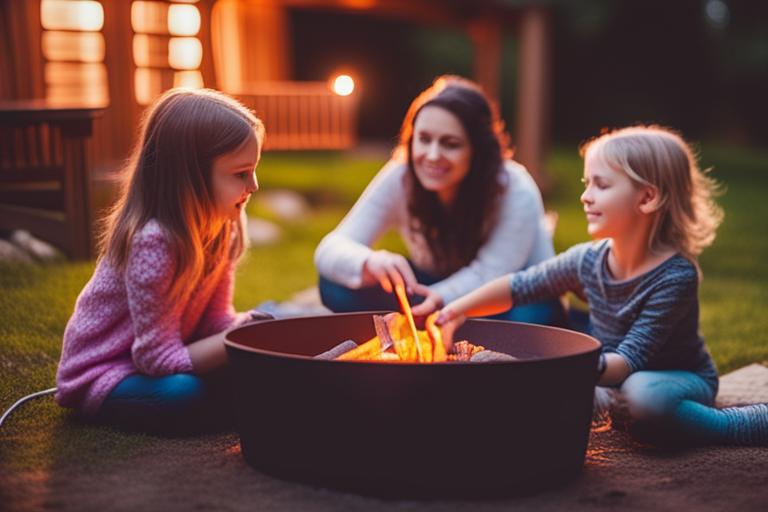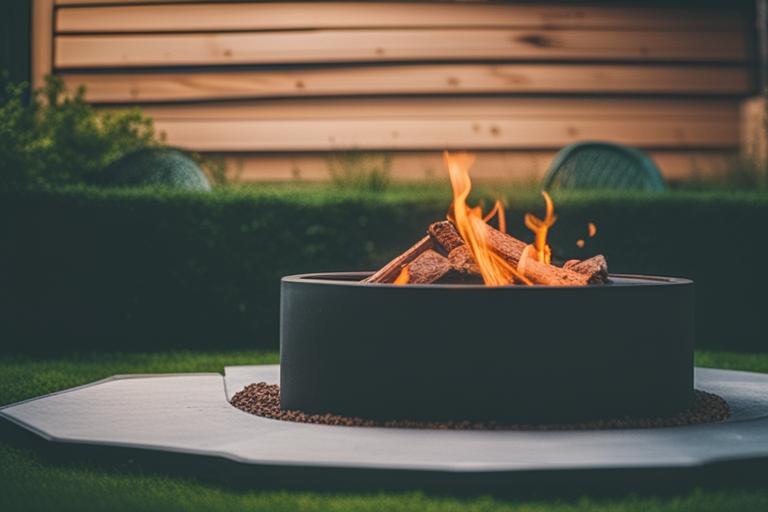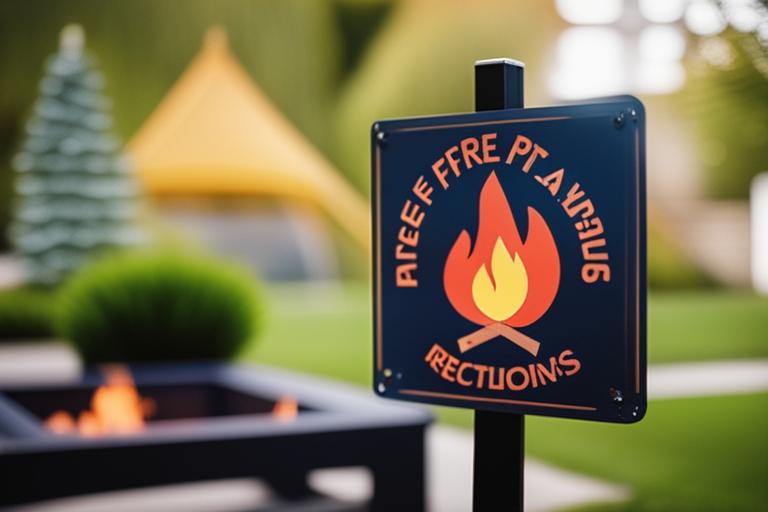Outdoor fire pits are a popular addition to many homes and gardens, providing warmth, ambiance, and a focal point for social gatherings. However, it’s crucial to use them safely to prevent accidents and injuries. In this article, we’ll provide a comprehensive guide to using outdoor fire pits safely and responsibly and answer the question, “Are outdoor fire pits safe?”.

Outdoor Fire Pit Safety Guide
By reading this article, you will learn:
– The risks associated with outdoor fire pits
– The importance of safety features, location, fuel sources, weather conditions, and regular maintenance
– Legal requirements for outdoor fire pits and additional safety tips

Benefits of Outdoor Fire Pits
Outdoor fire pits offer several benefits, such as:
- Warming up chilly evenings
- Creating a cozy atmosphere
- Providing a focal point for social gatherings
- Serving as a cooking source for outdoor meals
- Roasting marshmallows or making s’mores

Risks Associated with Outdoor Fire Pits
| Fuel Source | Risks |
|---|---|
| Wood | – Increased risk of starting a fire – Smoke can cause health issues – Requires regular cleaning to prevent buildup of flammable materials |
| Propane | – Cleaner burning option – Requires special equipment and installation – Can be more expensive than wood |
| Natural gas | – Cleaner burning option – Requires special equipment and installation – Can be more expensive than wood |
Despite their benefits, outdoor fire pits pose several risks, such as:
- Fire hazards
- Health risks due to smoke inhalation
- Safety concerns related to children and pets
Improper use of fire pits can cause burns, property damage, and even wildfires. The smoke generated by the fire can also cause health issues, especially for those with respiratory problems.
Safety Features of Outdoor Fire Pits
Several safety features are available to minimize the risks associated with outdoor fire pits, such as:
- Screens
- Covers
- Spark guards
These features help prevent sparks from flying out of the fire pit and catching on nearby flammable materials. Screens or covers can also act as a barrier to prevent children or pets from coming too close to the fire.

Choosing a Safe Location for the Fire Pit
Selecting a safe location for the fire pit is crucial to prevent accidents and injuries. Follow these guidelines to choose a safe location for your fire pit:
- The fire pit should be at least 10 feet away from any buildings, trees, or flammable materials.
- It should be placed on a non-combustible surface, such as concrete or brick.
- It should be away from any overhanging branches.
- Proper ventilation is also important to ensure the smoke is not trapped in a confined space.
Fuel Sources for Outdoor Fire Pits
Different types of fuel sources are available for outdoor fire pits, such as:
- Wood
- Propane
- Natural gas
Wood is the most common fuel source, but it also poses the greatest risk of starting a fire. Propane and natural gas are cleaner-burning options, but they require special equipment and installation. Regardless of the fuel source, it is essential to follow the manufacturer’s instructions for safe use.
Impact of Weather Conditions on Outdoor Fire Pit Safety
Weather conditions can also impact the safety of outdoor fire pits. It is important to check weather forecasts before using the fire pit and only use it in appropriate weather conditions. Windy conditions can cause sparks to fly out of the fire pit, while dry conditions increase the risk of starting a wildfire.
Regular Maintenance for Outdoor Fire Pits
Regular maintenance is necessary to keep the fire pit functioning safely. Follow these guidelines for regular maintenance:
- The fire pit should be cleaned regularly to prevent the buildup of flammable materials.
- Check for any damage or wear and tear, such as cracks or rust.
- Replace any damaged parts or features immediately.

Legal Requirements for Outdoor Fire Pits
Laws and regulations related to outdoor fire pits vary by location. It is important to check local ordinances and obtain any necessary permits before using the fire pit. Some areas may have restrictions on the type of fuel source that can be used, the size of the fire pit, and its location. Failure to comply with these regulations can result in fines or legal consequences.
Additional Safety Tips
To ensure safe and responsible use of your outdoor fire pit, follow these additional safety tips:
- Have a fire extinguisher nearby.
- Never leave the fire pit unattended.
- Keep children and pets away from the fire pit.
- Use long-handled tools to tend the fire.
- Avoid using flammable liquids to start the fire.
- Do not burn trash or other materials in the fire pit.
Personal Experience: Importance of Proper Ventilation
I recently hosted a small gathering in my backyard with family and friends. We decided to use our outdoor fire pit to create a cozy and warm ambiance. While we had used the fire pit before, we had not paid much attention to ventilation.
As we sat around the fire pit, we started feeling suffocated due to the smoke that was not dissipating. We realized that the fire pit was positioned in a poorly ventilated area, and the smoke was not able to escape.
We immediately moved the fire pit to a more open area, and the difference was remarkable. Not only did the smoke clear out, but the warmth from the fire pit was now reaching us more effectively.
This experience taught us the importance of proper ventilation when using outdoor fire pits. It is crucial to ensure that the fire pit is positioned in an area where smoke can escape easily, and there is proper air circulation.
I now always make sure to check for proper ventilation before using the fire pit, and I encourage others to do the same. It can make a significant difference in the overall safety and enjoyment of using outdoor fire pits.
Personal Anecdotes
To illustrate the importance of safe and responsible use of outdoor fire pits, here are a few personal anecdotes:
- Julia bought an outdoor fire pit and placed it too close to her house. One night, a spark flew out of the fire pit and caught the nearby bushes on fire. Luckily, she had a fire extinguisher and was able to put it out quickly.
- John used his outdoor fire pit during a windy evening, and a gust of wind blew several sparks out of the fire pit and onto his wooden deck. He didn’t have a spark guard or cover, and the sparks caused damage to his deck.
- Sarah had a small fire in her outdoor fire pit and left it unattended for a few minutes to grab some food. Her dog ran over to the fire pit and got too close, causing his fur to catch on fire. Thankfully, she was able to put out the fire quickly and her dog only suffered minor burns.
Conclusion
So, are outdoor fire pits safe? Yes, they can be, as long as they are used safely and responsibly. By following safety guidelines, choosing a safe location, using the appropriate fuel source, and regularly maintaining the fire pit, accidents and injuries can be prevented. It is also important to comply with any legal requirements in your area and take additional safety precautions, such as having a fire extinguisher nearby and never leaving the fire pit unattended.
Questions & Answers
Q. What are the safety precautions of using an outdoor fire pit?
A. Keep a safe distance, place it on a heat-resistant surface, and have a fire extinguisher nearby.
Q. Who should avoid using outdoor fire pits?
A. People with respiratory problems should avoid inhaling the smoke.
Q. How can I maintain my outdoor fire pit for safety?
A. Regular cleaning and proper storage in the off-season can help maintain safety.
Q. What should I do if the fire becomes too big?
A. Have a fire extinguisher nearby and call 911 if the fire becomes unmanageable.
Q. How can I prevent sparks from flying out of the fire pit?
A. Use a spark screen to prevent sparks from flying out of the fire pit.
Q. What if my homeowners association prohibits outdoor fire pits?
A. Look into other options such as propane fire pits or portable fireplaces.
Follow us!!